It’s funny to see how some “newcomers” can take a nation’s food scene by storm.
Nowhere is this as true as in Papua New Guinea and the kaukau, or the sweet potato. It’s rare enough to find recipes from Papua New Guinea as is, but it’s even rarer to find one that doesn’t involve some kaukau in one way or another.
For a country that has traceable roots spanning at least 40,000 years, it’s intriguing to see an ingredient become so prevalent in just under 500.

Kaukau, The Spanish, Camote and Biodiversity
It should come as little shock by now, but a key driving factor in the sweet potato’s ubiquity in Papua New Guinea comes via European colonialists.
And in this case – as we’ve seen in places like Chile and Haiti – it’s that Spanish that return to the scene here.
The Spanish Influence
For the most part, much of Papua New Guinea’s history seems fairly undisturbed by the outside world. Archaeological evidence suggests that the island had been inhabited by various peoples across its diverse geographies as early 40,000 years ago and perhaps even earlier (though this is slightly debatable).
Much like in the Philippines, Papua New Guinea saw a massive influx in population following the Austronesian Expansion of circa ~4000 BC. However, this infusion did not help to create a “pan-Papuan” culture, if you will. Partially due to the denseness of the forests and the island’s overall fractured topology, smaller tribes would stay isolated from one another and would develop their own mini-cultures. As a result, even to this day Papua New Guinea is home to 7,000+ different cultural groups and 850+ spoken languages, giving it the most diverse population in the world given its land density.
By the early 16th century, both Portuguese and Spanish explorers began to make their way to the island. The Portuguese technically arrived first – and Portuguese explorer Jorge de Menezes getting credited for the term “Papua” denoting Melanesia frizzy hair – although it was the Spanish that made a truly lasting impact.
Partially due to a perceived unattractiveness of the economic opportunity, the Europeans (including the Dutch, British and Germans later on) left the island alone and used it more as a “stopover” en route to other trade routes or colonies in their respective empires. Eventually, the island that had become known as New Guinea – in the 1540s Spanish explorer Ynigo Ortiz de Retez was reminded of the African Guinea colony, and the name stuck – would be divided and annexed by different colonial powers, but that’s a story for another day.
It was thanks to this earlier, relatively peaceful contact with the Spanish, however, that the sweet potato or kaukau made its way to the island.
You May Also Like….
Do you love recipes that uses rich coconut milk such as this one? Then you ought to check out our coconut milk ceviche from Fiji made with mahi mahi (kokoda), or our coconut conch soup sweetened with yucca and plaintains from Honduras (sopa de caracol), or if you’re feeling particularly adventurous and can get your hands on some banana leaves, try a shrimp coconut curry served on banana leaves for extra flavor!
The Rise of the Kaukau
One thing the Spanish Empire seems to have been particularly good at was the spread and dissemination of goods across its colonies and others it came in contact with. Specifically in the case of Papua New Guinea, that has meant the introduction of the sweet potato.
Before spreading across the world, the sweet potato was originally grown in Central and South America for thousands of years. The Incans in particular made very abundant use of this very special tuber, although it was consumed across societies all over the continent.
As we know from their expeditions to places like Peru, the Spanish discovered the South American continent while trying to forge a trade route with the East Indies. The greater discovery – and contact with local peoples like the Incans – led them to the sweet potato, which quickly made its way back to the homeland.
Because it was considered a highly nutritious food (and still is!), the sweet potato – called both camote and batata – became a staple on Spanish expeditions to other pockets of the world. As luck would have it, Papua New Guinea would eventually become such a pocket.
The sweet potato, which is called kaukau throughout Papua New Guinea, became an instant hit with the local population. Coupled with an agriculturally-driven society and a tropical climate in which it thrives, and the rapid evolution of kaukau had begun.
The Many Different Kaukau
What’s fascinating about the rise of the sweet potato is how diverse and significant it has become in Papua New Guinea. In Zambia, there is an awesome recipe on sweet potato fritters that you might want to check out.
In just 400 years of cultivation, there are now 417 different species of kaukau being grown across Papua New Guinea’s agricultural landscape. More astoundingly, the sweet potato has come to represent 90% of all calories consumed in the average daily diet in Papua New Guinea. From a cultural standpoint, it has made its way to play a prominent role in the different traditions across the multitude of tribes and societies.
For a country as demographically heterogeneous as Papua New Guinea is, it’s the sweet potato that has emerged surprisingly homogeneous in such a short period of time.

About the Recipe
Technically, there are plenty of different ways to cook kaukau, a term which really only implies the sweet potato element of the dish. You can really do all sorts of things with kaukau if you’d like.
A very common – and incredibly easy! – recipe to make is kaukau with coconut, which both is served as an everyday food as well as for ceremonies and special occasions.
Really, though, there’s very little to making the dish itself. To start, you’ll want to pre-bake your sweet potato to soften it. You’ll see why in a second, but the softer you can get the kaukau without it baking all the way to mush, the better.
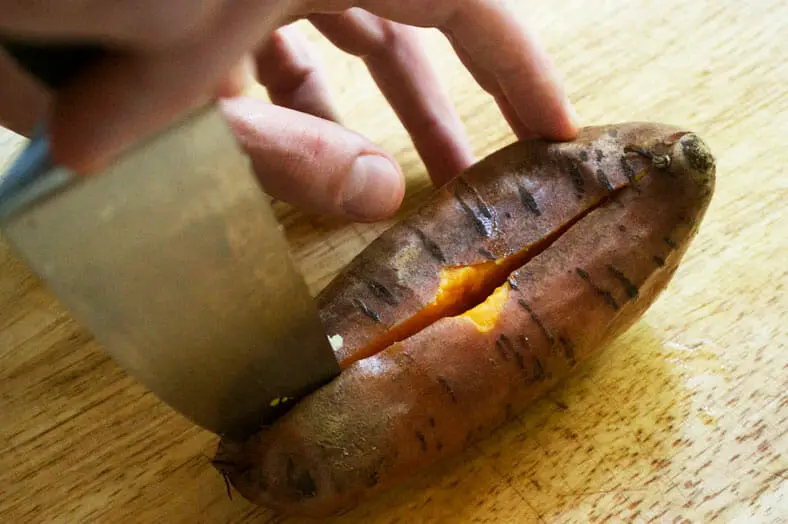
Once you have your softened sweet potatoes, you’ll want to very carefully hollow them out of their skin. Both for presentation as well as for cooking purpose, try to keep the skin as intact as you can.

For the inside of the kaukau, place it into a bowl and start to mash it. As you puree it by hand, you’ll either add butter or, in our case, coconut oil that will melt and fold into the sweet potato. From there, you’ll want to add various other aromatic ingredients like shallots, garlic, ginger and more. You’ll also want to add – if you’d like – dashes of orange juice and cinnamon into the mash as well.
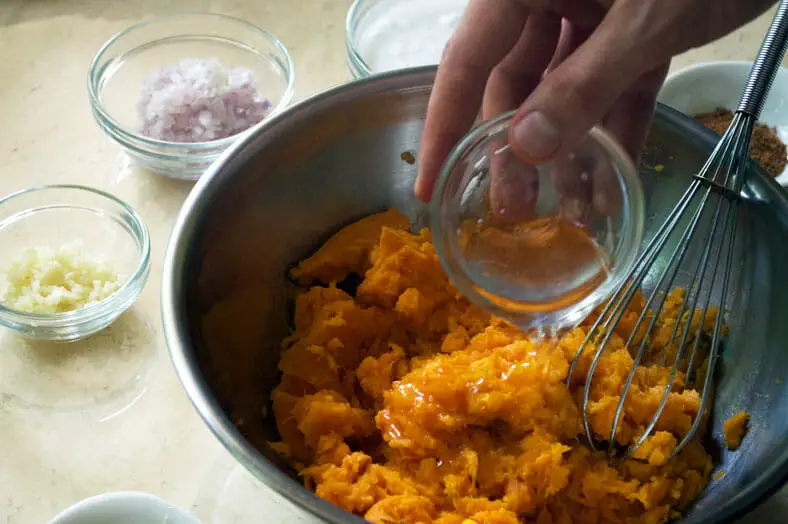

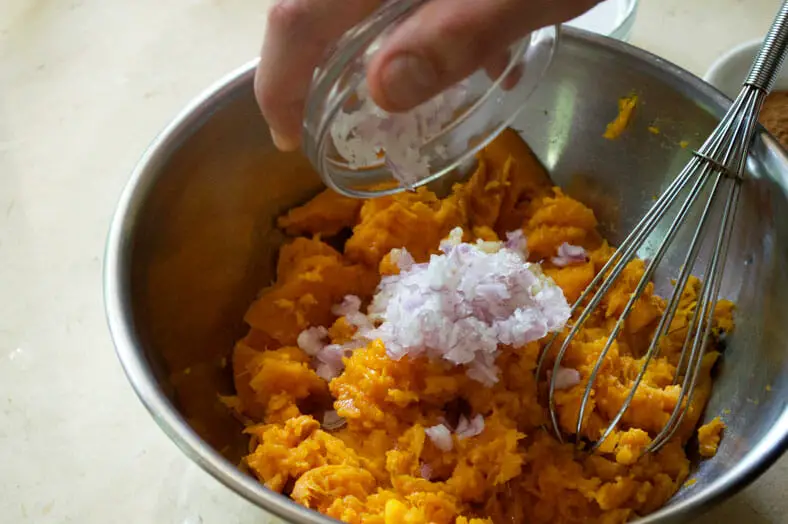

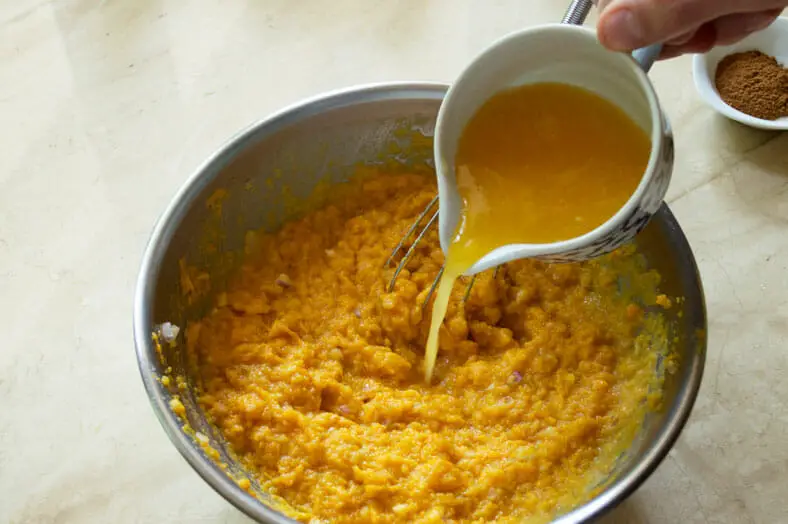
Now that your potato skins have cooled down and started to re-harden again, you can (still gently!) scoop your kaukau coconut mash into the “potato skin canoe” until you’ve filled it up as best you can. Pop it in the oven for a few extra minutes, and you’re done!
Our Take on the Recipe
Now again, there’s not a whole lot when it comes to recipes from Papua New Guinea, and admittedly there were some slim pickings in trying to find a baseline reference.
Nevertheless, we found two recipe sources – one from 196 Flavors and one from the ALWS – that seemed equally fitting to be our references.
From the outset, we recognized that this could be a recipe easily made into a vegan-friendly version, which is exactly what we did. In place of butter, we used coconut oil, which seemed more fitting to add to a coconut kaukau recipe anyways than butter. We also omitted any types of eggs and cheeses from the recipe altogether.
As a sort of a mash-up (pun intended), we combined the use of orange juice and cinnamon into our own version of the recipe to balance against the intense flavors brought on by the garlic and shallots. We definitely believe that including both ingredients helped bring much-needed harmony.
Other than that, there’s little else you can do to a dish as simple and with so few ingredients required. And of course, the greatest form of sophistication is simplicity. We love recipe that uses coconut milk such as this one. If you do, too, you should try our coconut milk ceviche or coconut conch soup.
Enjoy!
What would you add to your coconut kaukau? Comment below!


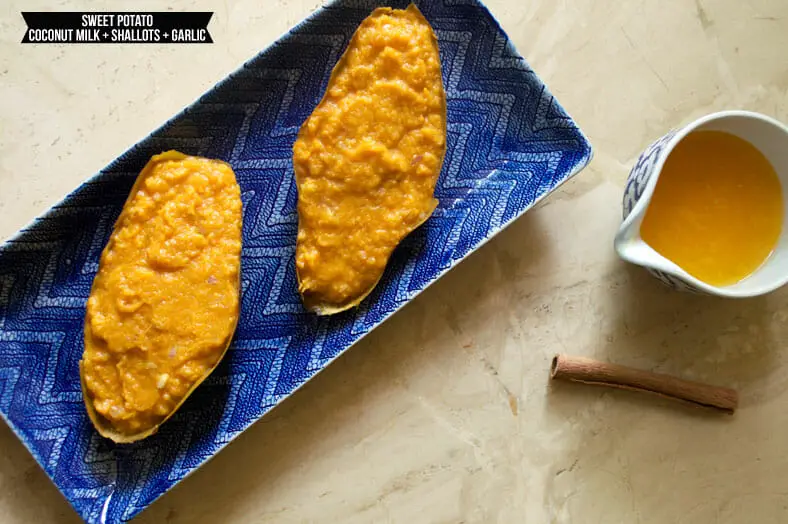
I shall try it